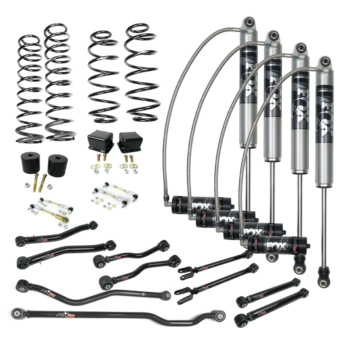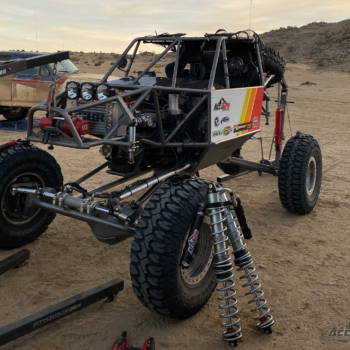This article will help guide you on how to measure for universal fit coilover shocks for a solid axle vehicle.
Over the years, high performance coilover shocks have become popular for off-road vehicles with custom built suspension. Going with a coilover shock can be a great option since they can be tuned and setup for just about anything. AccuTune Offroad specializes in tuning coilover shocks for anything from recreational 4x4s to extreme off-road racing. As a shock expert, we are determined to help customers pick the best coilover shock for their application, and do it right the first time. Below, we will go over a few of the essential measurements needed to choose the correct size coilover shock for your build and make a few recommendations along the way.
Terminology:
Ride Height – The final height of vehicle sitting on level ground.
Full Bump – Axle is level, and compressed all the way up to the frame, with bump stops fully compressed.
Full Droop – Axle is furthest from frame until other components start to bind or rub.
Up Travel – From ride height, the amount of shock travel going to full compression.
Down Travel – From ride height, the amount of shock shaft travel you have going to full extension.
Fitment
When measuring for shock length, keep in mind the space and location of where these shocks will be mounted. Find a good place on the axle or control arm to mount the coilover shock. Try to mount the coilover shock as far out on the axle as possible. This will help with clearance issues that come into play during articulation. Keep enough diameter space to fit a 3.5″ or 4.0″ (Outside Diameter) spring on the shock for 2.0 & 2.5″ shocks, respectively. Also note any upper shock mount restrictions, like the hood or fenders.

Ride Height
With your build platform and off-road driving style in mind, you need to figure out what your approximate ride height will be. The lower you are the more stable the vehicle will be, however you may lose the ground clearance or up travel needed for high speed off-road driving. Ride height is more of a personal preference, there is no right or wrong height. Once the vehicle is at your desired ride height, you may want to bolt the tires onto the axles to check for ground clearance and fender clearance. Before cycling the axle for shocks, it would be ideal to have suspension links in place, or at least mocked up.
At this point, don’t be too concerned about ride height, as this may change once we start to narrow down shock length options.
Up Travel
With chassis sitting at ride height, jack the axle straight up as far as it will go until it hits the frame/engine or you encounter binding on driveshafts or steering. It would be a good idea to have the correct size tires you will be using mounted to the axle to check for fender clearance. Depending on the type of build (Rock Crawler Buggy, Prerunner etc.) take note of what hits or binds. If you are able to cut or re adjust something to get more up travel, this may be something to consider later on. At full bump, measure from where you will be mounting the bottom of the shock on the axle, to where you will mount the top of the shock. Now add 1″ to the overall length of that measurement. This extra 1″ will make up for the 5/8″ bumper stop on the shock shaft, and the 3/8″ of extra shaft showing. At full compression, we want to have a little extra room for movement, so the 1″ rule allows for that.
This will be your compressed shock length dimensions.
Minimum Up travel suggestions (solid axle)
Rock Crawling = 4” Trail Riding = 5” Desert Racing / Ultra4 Type = 7”
We suggest dedicating 1/3 to 2/3 of shock travel for up travel, depending on application.

Down Travel
Using the same concept for compressed shock length, we need to measure for the extended length of the shock. With the chassis still at ride height, lower the axle as far as you can until steering, driveshaft or something else stops you from going further. Do not go over board on drooping the axle. If you’re reading this, you’re probably not building a Trophy Truck so too much droop will cause issues. With your extended length measurements, you should start to have a good idea on what travel shock you want to run. Common sizes for off-road shocks are: 10″, 12″, 14″ and 16″.
Down Travel Suggestions:
9” droop max, otherwise springs too soft and the vehicle will not handle well.
Articulation
Once you have a pretty good idea where the axle will cycle up and down, it’s time to articulate the axle one side at a time. When the axle flexes, the shocks will get very close to the frame and tires. Keep an eye on these locations and check for clearance issues. Fenders, bumpers are also common areas where the tire will come into contact with. If you run into clearance issues, try repositioning the shock mounting location to alleviate rubbing or consider cutting fenders. Make sure to cycle both sides of the axles with tires spinning, turned both ways. During this phase of measuring, it’s important to be thorough and accurate. Note that the shock may bottom out on articulation, this is ok and helps to prevent the tire from getting into things. Measure twice, order shocks once! Cycle axles/tires as much as you can to make sure everything is smooth. If you think you might go up a tire size later on, you may want to compensate for that now.

Summary Notes:
-1/3 to 2/3 of the shock should be up travel.
-Do not exceed 9″ of droop.
-14″ shocks are most common, then 12’s, then 16’s.
-It may be necessary to adjust ride height and repeat this process a few times.
-If you want more than 16″ of travel consider a Trailing Arm Suspension design.
-18″ coilovers offer very few spring choices.
Shock and Spring Consideration
Based on the measurements you have gathered, its time to check for shock options that are close to your specifications. Compare your compressed and extended lengths to the shocks you are considering, make sure you choose shocks with adequate up travel and down travel. If you find yourself wanting more shock travel, consider a trailing arm suspension setup (Coilover mounted to control arm).
Once you have an idea on the type of shock you want, we can take it from there. Simply fill out this quote request form with your vehicles information and email it into us. As part of our complimentary service, we will calculate springs rates and discuss tuning options with you. We will custom tune each coilover shock based on how the vehicles built and the way it will be driven, free of charge. Coilover springs also come with an unlimited spring swapping program, so we ensure you get the correct spring rates for your build.
If you have any further questions, please feel free to send us an email or call: Sales@Accutuneoffroad.com (424) 377-0808
Coilover Shock Quick Links:













Very good article on how to measure properly for the correction set of coilovers.
It’s a really impressive and well-elaborated blog. Also, thanks for sharing that amazing video.
Very well done , great article ! Customer service at its finest . That has helped me to decide I will be going with Accutune for my suspension set up for sure . Fox coil overs on my Ranger 😉 can hardly wait . Thanks guys